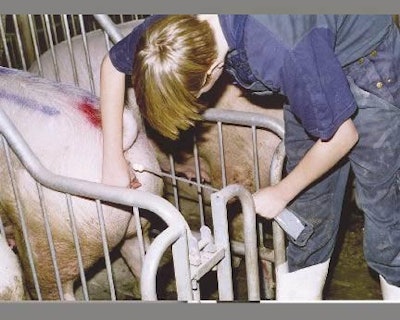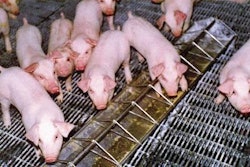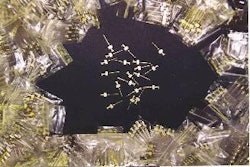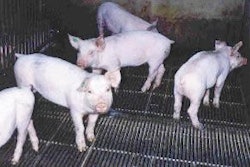
It is impossible to set a precise standard for the amount of time that herds should take to inseminate their sows. Past investigations have shown big differences from unit to unit and often with little or no correlation to the fertilisation results they obtained. It is clear also that the allocation of man-hours for insemination depends on herd size, the larger enterprises generally needing less time on a per-sow basis. But there are some general principles affecting the labour inputs involved with insemination, for all herd operators to consider.
So says Lei Timmermans at one of Europe's largest pig artificial insemination services, Varkens KI Limburg in the Netherlands. He points, for example, to the influence on working practice from the layout and fittings of the mating area. Inseminating takes up less time in those Eros Centre' rooms that put a boar in front of the sows so they stand better. The boar needs to be near to recently weaned sows in order to stimulate them, but not penned with them continuously.
"All walking distances have to be kept as short as possible. The light in the mating pen is also of great importance," Mr Timmermans comments. "I recommend a diurnal rhythm of 16 hours light with 8 hours of darkness. The intensity of the lighting should be at least 100 lux at the level of the sow's eye."
Having all the sows in a group be in standing heat together, such as at Day-4-5 after weaning, strongly reduces the time spent per sow because the inseminations can be performed at more or less the same time. By the same token, a spread in the appearance of oestrus after weaning will negatively influence time expenditures. So the preparation for AI is all-important.
Ideally this starts from Day 2 with the stimulation of the sows by twice-daily intensive boar exposure. A typical ratio of 4 sows per boar would have 15 minutes of contact for the batch in each period of exposure. Once again, pen furniture affects results. The front of the sow's pen must be open enough to allow easy nose-to-nose contact between the sexes. After 15 minutes the boar is moved along to the next batch, not allowed to linger where he was in the passageway.
The total stimulation period is difficult to shorten except by working with more boars so the exposure of different sow groups coincides, Mr Timmermans observes. However, the work done on stimulating can be expected to be more productive if the sows are in the right physical condition after being weaned.
"Here in the Netherlands and abroad we see sows that have lost too much backfat in lactation," he remarks. "Losing 5 millimetres or more of fat while in the farrowing house will negatively influence the sow's return to oestrus. A loss of no more than 3-4mm seems to be ideal. But sows that have lost less than this amount can still give problems, if the environment in the herd is not correct. This can relate to climate control, to feeding or to health.
"The time needed to inseminate the sows that have come into oestrus does vary according to the equipment used and the procedure followed, in our experience. At this moment we think the best catheter for speed of insemination is a foam pipette used with an extension pipe and a semen pouch that is hung behind the sow. We find this can save 50% of the time when compared with using a spiral or Melrose-type catheter.
"Again, though, the mating area plays a big role. It must be possible to approach the back of the sow easily during insemination. There should be no restriction on working with your hands. Not every insemination place meets these requirements."
Do not forget the people factor, he adds. Some people are in too much of a rush to inseminate well. Others are so precise about the job that they end up taking too long. The general rule is likely to be that the herds where the operators work calmly with the pigs will achieve the best insemination speeds without sacrificing results.
The answer for a unit that feels under time pressure on inseminations could be to outsource the job rather than trying to do everything itself, according to Mr Timmermans. In the Netherlands, his AI service still offers visits from professional inseminators to clients who buy boar semen.
















